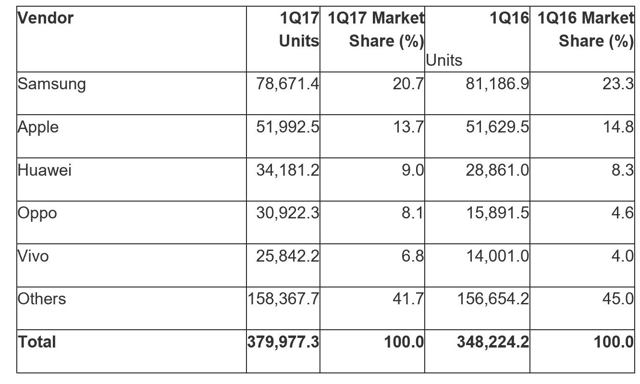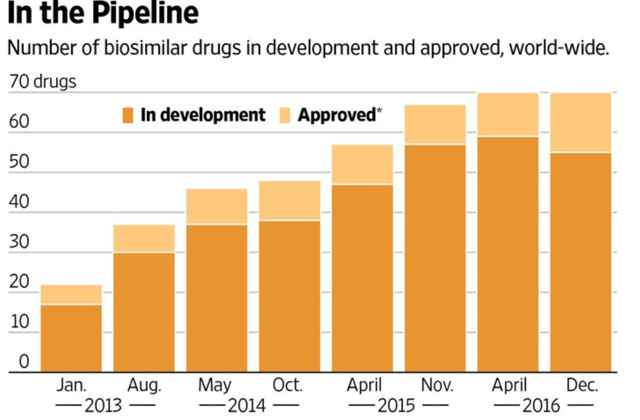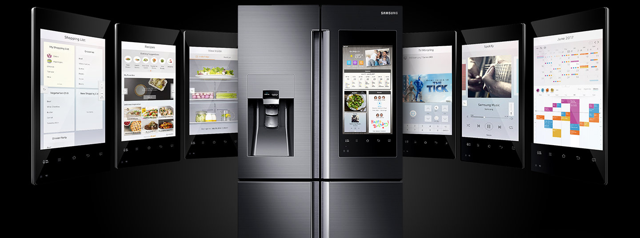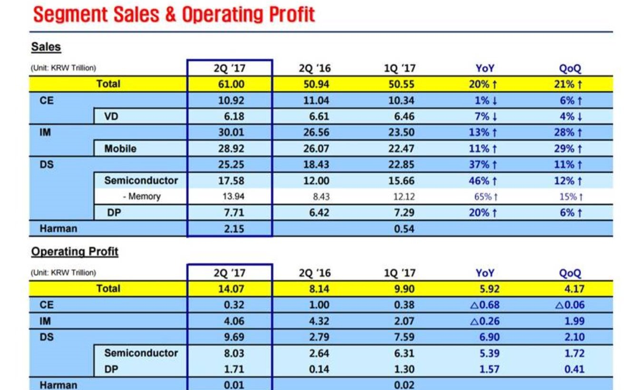Samsung, the world's leading smartphone maker, and Apple have pursued divergent strategies since the "patent wars" earlier in the decade.
Samsung's willingness to invest in R&D has led to stunning innovation across a wide range of products.
Samsung is now challenging companies like Johnson & Johnson in the pharmaceutical industry, Tesla in the EV and battery storage industry and Intel in the semiconductor industry.
Samsung is now the leading semiconductor manufacturer, surpassing Intel in Q2 2017. Intel had been the leader since 1991.
Although geopolitical risk and leadership uncertainty loom, Samsung has become one of the world's most innovative conglomerates.
IntroductionSeveral years ago, while standing on the steps of a San Francisco courthouse I heard Tim Cook proclaim that Apple (AAPL) could not continue to be the be technology developer for the world. He said this prior to a court hearing where Apple was suing Samsung (OTC:SSNLF) for allegedly copying the design of the iPhone. How the tables have turned. Relegated to a 14% world market share (Table 1) and struggling to innovate, Apple recently released the iPhone X which contains several key components that Apple is purchasing directly from Samsung. This report attempts to delineate the evolution of Samsung from a smartphone maker into a well-diversified, highly innovative international behemoth. Samsung has poured revenue into innovative R&D initiatives that have given rise to a cornucopia of new products. Although geopolitical risk and leadership uncertainty threaten stability, the company is on the verge of becoming the world's leader in innovative technologies.
 Table1. Worldwide smartphone sales by vendor Q1 2017 (in thousands of units). Gartner 2017.
Table1. Worldwide smartphone sales by vendor Q1 2017 (in thousands of units). Gartner 2017.
Although Samsung is the world's leading smartphone maker (Table 1) it may surprise some readers to know that Samsung only receives about 29% of its revenue from smartphones. Samsung's highly diversified portfolio includes semiconductors, flash memory, electric car battery technology, a full spectrum of Internet of Things (IoT) connected consumer electronics and home appliances, pharmaceuticals and more. Due to the limitations of space this report will focus on some of the innovations that investors may not even be aware of.
PharmaceuticalsOne of the most surprising aspects of Samsung's latest initiatives is its push into the pharmaceutical biosimilar arena. On April 24, 2017, the U.S. Food and Drug Administration (FDA) approved RENFLEXIS (infliximab-abda), a biosimilar, across all eligible indications. The company product announcement can be viewed here. In the US, RENFLEXIS is indicated for reducing signs and symptoms in patients with adult and pediatric Crohn's disease, adult ulcerative colitis, rheumatoid arthritis, ankylosing spondylitis and psoriatic arthritis, and for the treatment of adult plaque psoriasis. This biosimilar will compete directly with Johnson & Johnson's (JNJ) REMICADE and will be marketed in the US by Merck & Co. (MRK). The drug sells for $750 a vial versus $1,100 for REMICADE. A full year of treatment with the J&J drug costs more than $30,000. Samsung's push into biosimilars, a $260 billion market by 2020 according to EvaluatePharma (Image 1), has taken only fi ve years and is indicative of the rapidity of innovation that is a common theme across all of Samsung's product divisions. The company already has three other biosimilars that are being marketed in Europe and a significant pipeline of products in development. It is remarkable how quickly Samsung has burst upon the pharmaceutical scene and there is little doubt they will soon become a major player in this industry as they are investing heavily in R&D.

Image 1. Wall Street Journal 2017
IoT Enabled Consumer ElectronicsWith ten categories of home appliances Samsung is intent on transforming the home into something that once would have been considered science fiction. Consider the lowly refrigerator. Samsung has transformed this ubiquitous centerpiece of every kitchen into an internet-connected family hub (Image 2). The device is literally the command center for family life. Not only can you look inside the refrigerator from work via your cell phone to determine whether you need to restock, you can also simply just tell your refrigerator to order whatever it is you need from Amazon Fresh (AMZN). The interface serves as a family chore and appointment scheduler, video streaming display, music player, photo display and more. The entire family is connected to the hub via their electronic devices and can receive notifications and check schedules from anywhere. All of the apps on your phone show up on the family hub screen as well. Samsung has also employed similar innovative strategies to recreate the other appliances in the home, all in a way that both improves efficiency and simplifies daily tasks.

Image 2. Samsung Refrigerator/Family Hub
Self-driving vehicles and battery storage technologySamsung has announced a strategic partnership with TTech to provide next generation autonomous and safety technology to automakers. Harman International (NYSE:HAR), a wholly-owned subsidiary of Samsung, focused on connected technologies for automotive, consumer and enterprise markets, recently announced the launch of Harman's Remote Vehicle Updating OTA version 11 solution, based on technology Harman obtained through the acquisition of Redbend in 2015. Seventeen OEMs have chosen Harman's OTA solution enabling 25 million vehicles, making it the only commercially deployed OTA option on the market. Samsung has also purchased a significant stake, along with Warren Buffett, in the Chinese plug-in electric vehicle manufacturer BYD (OTCPK:BYDDY), which is the world's number one seller of electric cars and buses two years running with more than 100,000 units delivered in 2016. Further, Samsung SDI revealed its latest battery technology recently at the Frankfurt Motor Show t hat could challenge Tesla for long range battery supremacy. Samsung's cylindrical lithium ion cells when grouped into battery modules will reportedly extend electric vehicle range 372 to 435 miles. For comparison, Tesla's (TSLA) flagship Model S has an all-electric range of 315 miles, the Long Range Model 3 has 310 miles of range, and Model X boasts up to 289 miles of driving range (Mashable). Samsung is also developing all-purpose battery storage technology for home and industry (Image 3).

Image 3. Artists rendering of Samsung's conception of a smarter future.
Business outlook and associated risk
Samsung Q2 2017 earnings reveal $12.1 billion (14 Trillion Korean Wan) in profit versus $7.18 billion (8.14TKW) in Q2016, a 72% increase year over year and topping analysts estimates. This has translated to a 32% increase in the stock price. For comparison the stock price has outpaced Apple by 10% in the last year and 85% in the last two years (Yahoo Finance). Further, return on equity grew from 13% to 22% (yoy) and EBITDA margin from 25% to 31% over the same period. Semiconductor sales grew to $15 billion in Q2, overtaking Intel's (INTC) $14.4 billion. Intel had been the sales leader since 1991 (Zacks Investment Research).

Table 2. Samsung Electronic Segment Sales and Operating Profit
Geopolitical risk associated with North Korea remains a threat but so far the market has shrugged it off. The larger uncertainty may be associated with the Vice-Chairman of Samsung, Lee Jae-yong, who has been convicted for bribery and embezzlement and sentenced to five years in prison. Lee's lawyer will appeal the conviction. But if the conviction is not overturned there will be a management shake up. Samsung is a family run conglomerate.
Conclusion
Investors in the United States that do not have access to the Korean stock market (KOSPI) must turn to ETFs or Mutual Funds in order capture a piece of Samsung. The Vanguard Pacific Stock Index (VPAIX), Vanguard FTSE Pacicific ETF (VPL) and the iShares MSCI Emerging Markets Index ETF (EEM) all feature Samsung as a top holding. The grey market (NASDAQ:OTC:SSNLF) is a thinly traded alternative.
Samsung's evolution over the past five years following the great "who is copying who" debate with Apple has simply been astounding. Where Apple seems content to run in place, Samsung has evolved into an Iron Man tri-athlete behemoth well on its way to becoming the most innovative company in the world. I feel Apple's strategy of hoarding cash has placed a stranglehold around the neck of innovation at the company whereas Samsung's strategy of pouring money back into R&D has allowed the company to diversify its product portfolio well beyond the smartphone market. This discussion did not even touch on Samsung's primary source of revenue, state of the art DRAM and NAND technology, where it is the world leader. Not to mention the dominance the company has in organic and active matrix organic light emitting diode screens for phones, televisions and other electronic devices. Watching what innovation Samsung will introduce to the world next has become much more excitin g than waiting for the next iPhone release. Although there are risks that must be considered, the future is looking very bright for Samsung investors.
Disclosure: I am/we are long JNJ MRK.
I wrote this article myself, and it expresses my own opinions. I am not receiving compensation for it (other than from Seeking Alpha). I have no business relationship with any company whose stock is mentioned in this article.
Editor's Note: This article discusses one or more securities that do not trade on a major U.S. exchange. Please be aware of the risks associated with these stocks.
Source: Evolution Of Samsung Since The Smartphone Patent Wars
Comments
Post a Comment